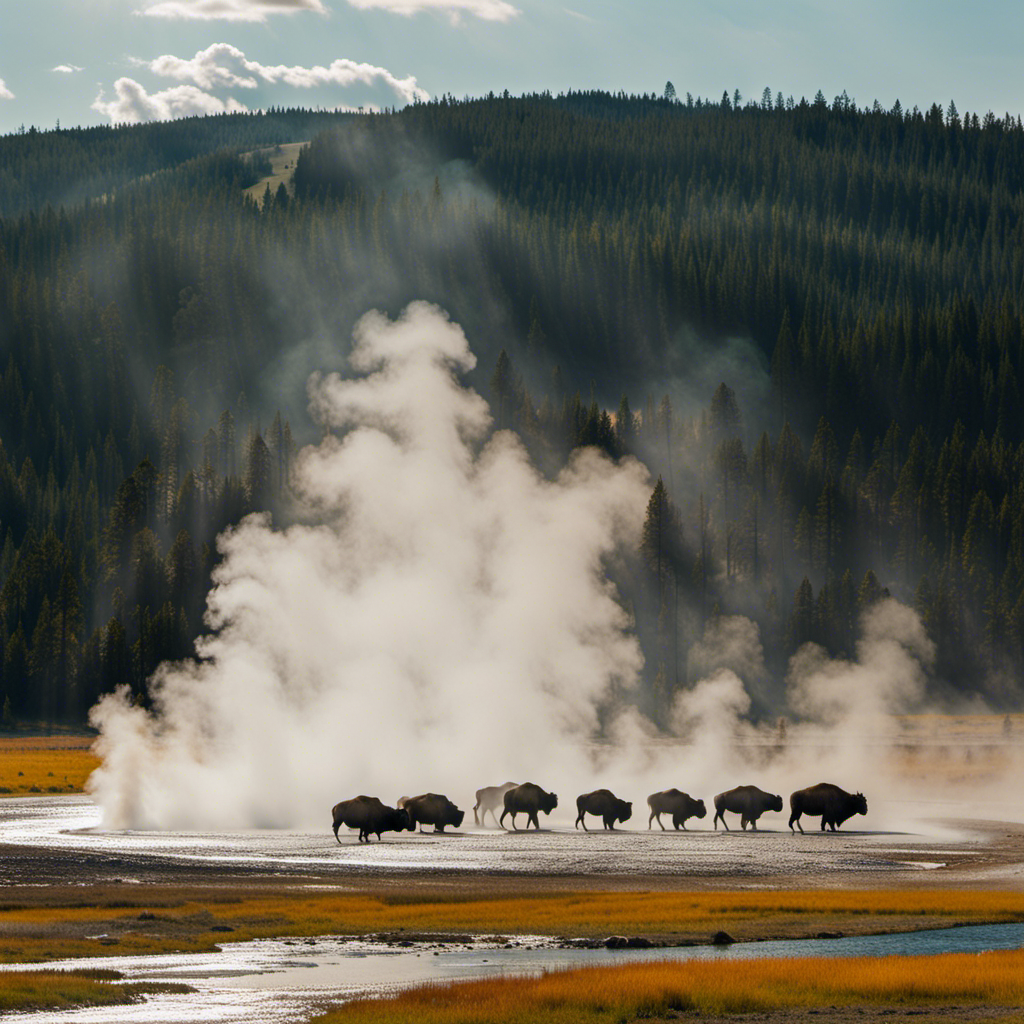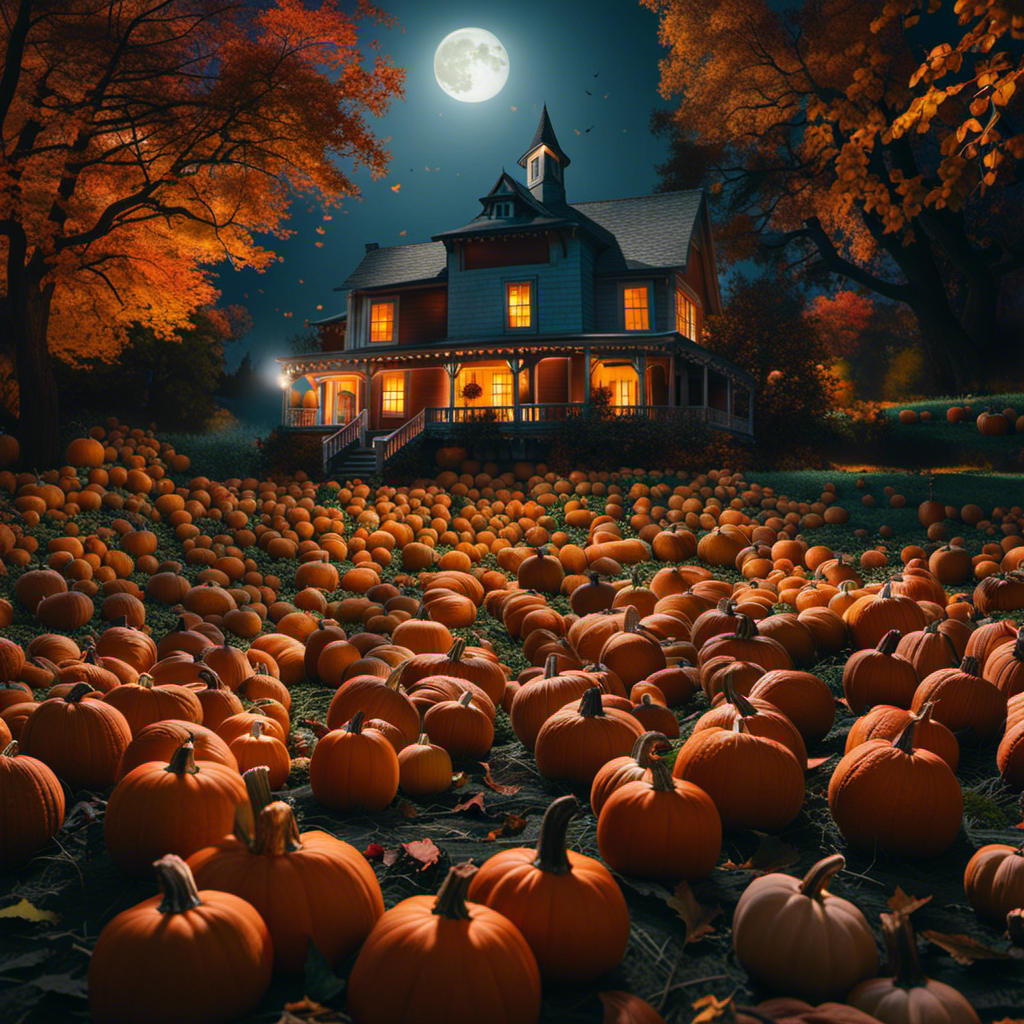Do you ever wonder about the mysterious world of shadows? Well, get ready to embark on a journey filled with fascinating discoveries and mind-blowing facts!
In this article, we will unveil the secrets behind shadow formation, explore different types of shadows, and delve into the science that governs their behavior.
From cultural beliefs to their connection with time of day and weather, you’ll be amazed by how shadows can shape our lives.
So join us as we dive into the captivating realm of shadows!
Key Takeaways
- Shadows can change in size and shape as the distance between the object and the surface alters.
- Understanding the effects of light sources on shadows unlocks captivating visual possibilities.
- The position of the light source determines where shadows fall.
- Shadows have cultural significance and beliefs associated with them.
Shadow Formation
Shadows form when an object blocks the light source. It’s like a dance between darkness and illumination, an interplay that captivates our imagination.
When sunlight or any other light beam encounters an obstacle, it creates a silhouette on the opposite side. These elusive companions have properties that are worth exploring.
Shadows can be long or short, depending on the angle of the light source and the position of the object casting them. They can also change in size and shape as the distance between the object and the surface alters.
Shadows possess a mysterious allure, drawing us into their world of contrast and intrigue. They remind us that even in darkness, there is beauty to be found, belonging to something larger than ourselves.
Types of Shadows
Do you ever wonder how the position and intensity of light sources can affect the formation of shadows? In this discussion, we will explore the fascinating effects that different light sources have on shadows.
From casting intricate patterns to altering their shapes and sizes, understanding these phenomena is key to unlocking a world full of captivating visual possibilities.
Prepare to be amazed as we delve into the mesmerizing realm where light and shadow dance in perfect harmony.
Light Source Effects
When you shine a light on an object, it affects the way shadows are formed. Shadows can be more than just dark shapes on the ground; they have their own unique characteristics that change depending on how the light source interacts with the object.
Here’s what happens when light comes into play:
- Shadow direction: The position of the light source determines where your shadow falls. Move closer to or farther away from the light, and watch as your shadow shifts accordingly.
- Shadow intensity: The brightness of the light affects how dark or light your shadow appears. A stronger light source will create a darker, more defined shadow, while a weaker one will result in a lighter and softer silhouette.
Understanding these effects allows you to experiment with shadows creatively. So grab a flashlight and start exploring the fascinating world of shadows! You’ll be amazed at what you discover.
Shadow Size Variations
The size of shadows can vary depending on the distance between the light source and the object. This fascinating phenomenon leads to intriguing shadow size variations that are worth exploring. Imagine standing outside on a sunny day, observing your own shadow as it stretches out before you. As you move closer to a light source, such as a lamp or the sun, your shadow will become larger in size. Conversely, if you move farther away from the light source, your shadow will shrink in size. This concept is best understood through visualization, so let’s take a look at the table below for some examples:
| Distance (in feet) | Shadow Size |
|---|---|
| 1 | Large |
| 5 | Medium |
| 10 | Small |
As you can see, as we increase our distance from the light source, our shadow sizes gradually decrease. Understanding these shadow length variations adds depth and excitement to our understanding of how light interacts with objects around us. So next time you’re outside enjoying sunny weather, take a moment to marvel at the dynamic nature of shadows and their ever-changing sizes!
Shadow Length Variations
Have you ever wondered why shadow lengths vary throughout the day? Factors such as the position of the sun, the angle at which sunlight hits an object, and even the curvature of the Earth all play a role in determining how long a shadow will be.
Understanding these factors can provide fascinating insights into the dynamic nature of shadows and their ability to change shape and size. So next time you find yourself mesmerized by a unique shadow shape or puzzled by its length, remember that there is science behind it waiting to be discovered.
Factors Affecting Shadow Length
Are you curious about the fascinating world of shadows? Well, let me tell you something incredible.
One of the factors that affects shadow length is the position of the light source. Yes, it’s true! When the light source is closer to an object, the shadow becomes shorter. Conversely, when the light source is farther away, the shadow elongates. Isn’t that mind-blowing?
These variations in shadow length can create enchanting and mesmerizing visual effects. Imagine standing beneath a street lamp at night, watching your elongated shadow stretch out before you. It’s like stepping into another world!
Understanding these factors affecting shadow length allows us to appreciate how our surroundings can transform through simple changes in lighting. So next time you see a long or short shadow, remember that it’s all about where that light is coming from!
Interesting Shadow Shape
Did you know that shadows can actually take on some pretty unique shapes? It’s true! When light interacts with objects, it creates fascinating shadow illusions and shadow silhouettes that can captivate your imagination. These intriguing shapes can be found in everyday life, from the elongated shadows of trees at sunset to the distorted forms created by objects placed under a bright light. The playfulness of shadows offers endless possibilities for creativity and exploration. Just imagine the joy of using your hands to create various animal shapes or making shadow puppets on a wall. Shadows are not just dark areas devoid of light; they are an invitation to embrace your inner artist and discover the magic hidden within the interplay of light and darkness.
| Object | Light Source | Shadow Shape |
|---|---|---|
| Hands | Lamp | Animal Figures |
| Paper | Candle | Intricate Cutouts |
| Fingers | Overhead Sun | Silhouette Art |
So next time you see a shadow, don’t just dismiss it as a mere absence of light. Take a moment to appreciate its beauty and let your imagination soar as you explore the infinite possibilities that exist within these enchanting shadow shapes. Embrace the sense of belonging that comes from being part of this magical world where reality merges with illusion, and let your own unique creations come to life through the artistry of shadows.
The Science Behind Shadows
You’ll be amazed at how shadows form due to the interaction between light and objects. Shadows are created when an object blocks or obstructs the path of light. As light rays come into contact with an object, some are absorbed while others are reflected or scattered. The areas where light is blocked by the object appear darker, creating a shadow.
It’s fascinating to think about how shadows can vary in size and shape depending on the angle and intensity of the light source, as well as the distance between the object and the surface on which the shadow falls.
Shadows have been used for centuries to create captivating forms like shadow puppets, where performers manipulate their hands to cast intricate silhouettes against a backdrop. These playful creations allow us to explore our creativity and connect with others through storytelling using nothing but our hands and imagination.
So next time you see a shadow, take a moment to appreciate its beauty and remember that shadows hold endless possibilities for artistic expression!
Shadows and Light Sources
Light sources play a crucial role in determining the size and shape of shadows. Without light, there would be no shadows at all! Shadows can be fascinating and mysterious, adding depth and dimension to our world.
Here are three intriguing facts about shadows:
- Shadows and Color: Did you know that shadows can have color? When sunlight passes through different materials, it creates colored shadows. For example, if you shine a light through a red glass, the shadow will appear red. This phenomenon adds an artistic touch to our surroundings.
- Shadows and Depth Perception: Shadows also help us perceive depth in the objects around us. By observing how the shadow changes its size or position as we move closer or farther away from an object, our brain processes this information to understand distances accurately.
- Shadow Play: Shadows have been used for centuries as a form of entertainment. Through puppetry and shadow play performances, cultures around the world have embraced this art form to tell stories and create magical experiences.
Embrace the power of shadows – they bring color, depth perception, and endless possibilities into your life!
Shadow Play and Shadow Puppets
Imagine a world where shadows come to life, dancing and telling stories in the most captivating way.
In this discussion, we will uncover the historical origins of shadow puppets, tracing their roots back to ancient civilizations that marveled at the magic of light and shadow.
Delve into the cultural significance of shadow play as we explore how different societies have embraced this art form as a means of entertainment, education, and even spiritual enlightenment.
Get ready to be enchanted by the enchanting world of shadow play and discover why it continues to mesmerize audiences around the globe.
Historical Origins of Shadow Puppets
The historical origins of shadow puppets can be traced back to ancient China. These mesmerizing forms of entertainment have captivated audiences for centuries with their magical and enchanting performances. Here’s why shadow puppets hold such cultural significance:
- Creativity: Shadow puppetry allows you to unleash your imagination by creating intricate characters and stories using just your hands and light.
- Connection: Watching shadow puppets brings people together, creating a sense of shared experience and belonging.
- Tradition: Passed down through generations, shadow puppetry preserves cultural heritage and keeps ancient traditions alive.
- Escape: The world of shadow puppets offers an escape from reality, transporting us to fantastical realms where anything is possible.
Immerse yourself in the rich history and artistry of shadow puppetry, connecting with others, preserving tradition, and letting your creativity soar. Join the timeless tradition that has brought joy to countless individuals throughout history!
Cultural Significance of Shadow Play
Now that you’ve learned about the historical origins of shadow puppets, let’s delve into the cultural significance of shadow play. Shadow puppetry has been an integral part of many cultures around the world, with each region adding their own unique twist to this ancient art form. Beyond entertainment, shadow play holds deep symbolic meaning in various societies.
To give you a glimpse of its cultural importance, here is a table showcasing three different cultures and their interpretation of shadows:
| Culture | Shadow Puppetry Symbolism |
|---|---|
| Chinese | Represents traditional values and moral teachings |
| Indonesian | Reflects spiritual beliefs and ancestral spirits |
| Turkish | Portrays social commentary and political satire |
As you can see, shadows aren’t just fleeting images on a wall; they carry profound meanings within different cultural contexts. Exploring the depths of shadow symbolism allows us to appreciate the rich tapestry of human expression across diverse communities.
Shadows in Art and Photography
Artists and photographers often use shadows to create dramatic effects in their work. Shadows have the power to add depth, mystery, and emotion to a composition. By manipulating the placement and intensity of shadows, artists can evoke different feelings and captivate the viewer’s imagination.
Here are three ways in which shadows are utilized in art and photography:
- Shadow composition: Artists strategically arrange light sources and objects to create interesting shadow patterns that enhance the overall composition.
- Shadow manipulation: Photographers play with angles, exposure settings, and post-processing techniques to manipulate shadows and emphasize certain elements or convey a specific mood.
- Shadow symbolism: Shadows can symbolize hidden truths or represent the unseen aspects of our lives. Artists often use shadows metaphorically to explore themes of duality, secrets, or inner struggles.
Cultural Beliefs and Shadows
Cultural beliefs often shape how shadows are perceived and interpreted in different societies. The symbolism attached to shadows can vary greatly across cultures, revealing the deep-rooted significance they hold in our collective consciousness. In some cultures, shadows are seen as representations of the soul or spirit. They are believed to possess a mysterious power that connects us to the spiritual realm. Other cultures associate shadows with fear and darkness, viewing them as ominous omens or signs of impending doom. To further illustrate these diverse cultural interpretations, consider the following table:
| Culture | Shadow Symbolism |
|---|---|
| Japanese | Protection from evil spirits |
| Native American | Connection to ancestors |
| African | Symbol of duality and balance |
Shadows and Time of Day
As you go about your day, you’ll notice how the position and length of shadows change depending on the time of day. It’s a fascinating phenomenon that reveals the intricate dance between light and objects. Shadows hold secrets, and understanding their patterns can unlock a world of knowledge.
Here are three mind-blowing facts about shadow patterns and direction:
- Shadow patterns can be used to determine the time of day with surprising accuracy. By observing how shadows move, you can estimate whether it’s morning, noon, or evening.
- The direction of a shadow is influenced by the angle at which light falls on an object. This means that as the sun moves across the sky, shadows shift in different directions.
- Shadow play has been an ancient form of entertainment in many cultures. People have used shadows to create enchanting stories and captivating performances for centuries.
Embrace your curiosity and explore the wonders hidden within shadow patterns and their ever-changing direction. Join this age-old tradition and feel a sense of belonging to humanity’s timeless fascination with light and darkness.
Shadows and Weather
Weather affects the length and position of shadows, providing valuable information about the current atmospheric conditions. The temperature can influence the size of a shadow because warm air tends to rise, creating taller shadows, while cold air sinks, resulting in shorter shadows. Additionally, precipitation can also affect how shadows appear. Rain or snow can scatter light, making shadows less defined and blurry. On a sunny day with clear skies, you will experience sharp and well-defined shadows that stretch across the ground. However, on an overcast day with thick clouds, the absence of direct sunlight may cause your shadow to appear faint or almost nonexistent. Understanding how weather impacts shadows can help you better interpret your surroundings and deepen your connection to the natural world.
| Weather Condition | Shadow Effect |
|---|---|
| Sunny | Well-defined |
| Cloudy | Faint |
| Rainy | Blurry |
| Snowy | Undefined |
| Clear Night | Absent |
Remember that each weather condition has its own unique impact on shadow formation and appearance. By paying attention to these subtle changes in our environment, we can gain a greater understanding of weather patterns and become more attuned to nature’s rhythms. Embrace the beauty of shadows as they dance with light under different atmospheric conditions; it is through this exploration that we find a sense of belonging within our ever-changing world.
Shadows in Popular Culture
Movies and television shows often use shadows to create suspense and enhance the mood of a scene. Shadows are not just mere absence of light; they hold deeper meanings that can tap into our subconscious desires.
Shadow symbolism plays a crucial role in conveying hidden emotions, secrets, and even the darker aspects of human nature. It is through shadows that we explore the depths of our own psyche, uncovering the complexities within ourselves.
By incorporating shadow psychology into storytelling, filmmakers invite us to confront our fears, desires, and vulnerabilities. Shadows become a visual representation of our inner struggles and conflicts, providing a sense of belonging as we connect with characters who grapple with their own shadows.
So next time you watch a movie or show, pay attention to the shadows dancing on screen—they might hold more significance than you think.
Frequently Asked Questions
Can Shadows Exist in Complete Darkness?
Shadows can indeed exist in complete darkness. They play a fascinating role in perception, as psychologists study the relationship between shadows and our understanding of depth and shape. Shadows also hold cultural significance in art and literature, adding depth and symbolism to creative works.
How Do Shadows Change When Multiple Light Sources Are Present?
When multiple light sources are present, shadows can change in size, direction, and intensity. This happens because each light source casts its own shadow, creating a complex interplay of overlapping shadows that adds depth and dimension to the scene.
Can Shadows Be Different Colors?
Yes, shadows can be different colors! In art, shadows are often depicted with darker shades to create depth and contrast. Additionally, in different weather conditions like sunrise or sunset, shadows can appear warmer or cooler in color.
Do Shadows Have Any Effect on Our Health or Well-Being?
Shadows can have a psychological impact on your health and well-being. They can evoke fear or comfort, depending on cultural symbolism. Embrace the power of shadows and find belonging in their mysterious allure.
Are There Any Animals That Are Unable to Cast Shadows?
Did you know that there are shadowless creatures in the animal kingdom? Some animals, like certain types of fish and insects, have transparent bodies that prevent them from casting shadows. Fascinating, isn’t it?
Conclusion
Congratulations! You’ve uncovered the fascinating world of shadows. From their formation and variations to the science behind them, you’ve delved deep into this intriguing phenomenon.
Shadows may seem simple, but they hold a wealth of knowledge waiting to be discovered. So next time you see a shadow, remember that it’s not just a mere absence of light, but a doorway to understanding our world in ways we never thought possible.
Embrace the mysteries of shadows and let them lead you on an extraordinary journey of exploration and wonder.




